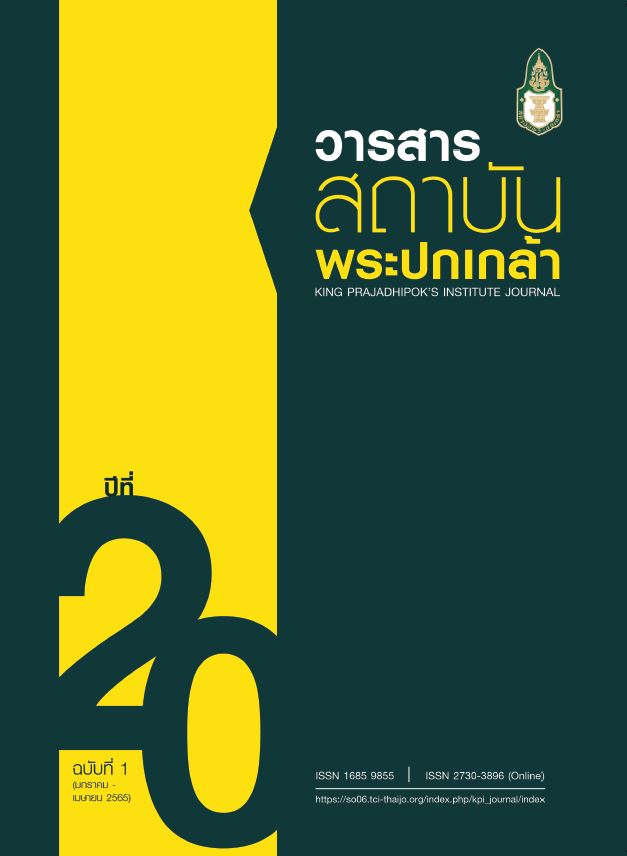Pluralistic Social Networking to Combat Fraud and Corruption in Thai Society: Roles and Policy Recommendations for Action
Main Article Content
Abstract
The objective of this article is to elucidate corruption in Thai society, present a potential role for pluralistic social networking in combatting corruption, and provide policy recommendations. Data were gathered from secondary sources in order to understand the phenomenon of corruption and its connections to the Thai social context, and a content analysis was conducted. The analysis found that there remains a high level of corruption in Thailand, and that corruption occurs in a variety of forms. The writer thus recommends pluralistic social networking, which is a response that combines a new public service orientation emphasizing citizen participation and area networking to, identify diverse players who can help combat fraudulent and corrupt activities. These players include youth and community representatives, as well as representatives from educational institutions, mass media, non-profit organizations, local government organizations, local districts, and the private sector. Three policy recommendations are presented: 1) A legal response should determine clear liabilities and penalties for corrupt activities, and laws should be reviewed in order to ensure that they are enforceable in an effective and appropriate manner according to current conditions. 2) Priority should be given to freedom of the press and people’s participation so that the media is allowed to present the news, opinions can be expressed as long as human rights are not violated, and people’s participation is encouraged in order to achieve participatory politics. 3) To promote good governance and transparency, all departments should enhance good governance, increase clarity of practice, and simplify the legal framework to reduce discretion and emphasize transparent management.
Article Details

This work is licensed under a Creative Commons Attribution-NonCommercial-NoDerivatives 4.0 International License.
@ 2020 King Prajadhipok's Institute The Government Complex Commemorating All Right Reserved.
References
เกรียงไกร ปัญญาพงศธร. (2561). การคอร์รัปชันในองค์กรปกครองส่วนท้องถิ่นในประเทศไทย : ศึกษากรณี เทศบาลนคร. วารสารวิจัยราชภัฏกรุงเก่า, 5(1), 55-62.
จุลศักดิ์ ชาญณรงค์. (2562). ความ “ใหม่”ของรัฐประศาสนศาสตร์. วารสารสหวิทยาการ, 16(2), 54-83.
โชคสุข กรกิตติชัย. (ม.ป.ป.). การลดลงของดัชนีชี้วัดภาพลักษณ์คอร์รัปชันของไทย ประจำปี 2563. ม.ป.พ.
ณัชชานุช พิชิตธนารัตน์. (2561). การทุจริตเลือกตั้งท้องถิ่นในจังหวัดเพชรบุรี. วารสาร สหวิทยาการวิจัย : ฉบับบัณฑิตศึกษา, 7(1), 72-81.
ณัฐฐา วินิจนัยภาค. (2554). นโยบายสาธารณะ: แนวทางในการศึกษาแบบสหวิทยาการ. กรุงเทพฯ: สถาบันบัณฑิตพัฒนบริหารศาสตร์.
ไทยโพสต์. (2564, 20 สิงหาคม). ผงะ! คอร์รัปชัน 15,282 กรณี ไม่เว้นแม้ภาวะวิกฤติโควิด. สืบค้นจาก https://www.thaipost.net/main/detail/113977
ไทยรัฐออนไลน์. (2564, 8 กรกฎาคม). ‘Whistleblower’ กฎหมายไทยช่วยอะไรผู้เปิดโปงความจริง ?. สืบค้นจาก https://www.thairath.co.th/scoop/theissue/2135651
ธนพร แย้มสุดา. (2560). การทุจริตทางวิชาการ : ปัญหาที่บั่นทอนความเข้มแข็งของสังคม. วารสารแพทย์นาวี, 44(3), 175-181.
นภธร ศิวารัตน์ และภักดี โพธิ์สิงห์. (2561). ทิศทางการคอร์รัปชั่นในประเทศไทย. วารสารสถาบันวิจัยและพัฒนา มหาวิทยาลัยราชภัฏมหาสารคาม, 5(2), 343-354.
นันท์วดี แดงอรุณ. (2563). ‘คนไทย’ กับบทบาทในการขับเคลื่อนกลไกเพื่อแก้ไขกลโกง. วารสารสำนักงาน ป.ป.ช., 20(74), 22-25.
นิภาพรรณ เจนสันติกุล. (2556). โครงสร้างทางสังคม บทบาทและนโยบายสาธารณะกับความเป็นพลเมือง. วารสารศิลปศาสตร์, 5(1), 49-62.
ปิยะพงษ์ บุษบงก์ และพบสุข ช่ำชอง. (2561). การให้ความสำคัญกับเครือข่ายในทางนโยบายสาธารณะและการบริหารจัดการ : มุมมองเชิงวิพากษ์และกรอบการวิเคราะห์สำหรับข้ามพ้นสัญญะที่กลวงเปล่า. วารสารสังคมศาสตร์ มหาวิทยาลัยนเรศวร, 14(2), 113-136.
พรอัมรินทร์ พรหมเกิด, วรัญญา ศรีริน, ธีรภัทร์ ลอยวิรัตน์ และเพิ่ม หลวงแก้ว. (2562). การศึกษาเครือข่ายกลุ่มอิทธิพลซึ่งนำไปสู่การทุจริตคอร์รัปชันอย่างเป็นระบบของภาคการศึกษา. วารสารวิชาการ ป.ป.ช., 12(1), 35-61.
วรพรรณ เขื่อนคง. (2563). สร้างนวัตกรรมด้วยการใช้ประโยชน์จากการเปิดเผยข้อมูล (Open Data) ภาครัฐ. วารสารตรวจบัญชีสหกรณ์, 1(1), 150-152.
วัชระ จิรฐิติกาลกิจ. (2563). ความสัมพันธ์ของเสรีภาพสื่อมวลชนกับการคอร์รัปชันในสังคมไทย. วารสารนิเทศศาสตรปริทัศน์, 24(1), 121-132.
วัชรา ไชยสาร และคณะ. (2561). การศึกษากลุ่มอิทธิพลซึ่งนำไปสู่การทุจริตคอร์รัปชันอย่างเป็นระบบ (Organized Corruption) จำแนกตามภาคเศรษฐกิจ : กรณีศึกษาการทุจริตภาษีมูลค่าเพิ่มและภาษีศุลกากรในประเทศไทย. กรุงเทพฯ: สำนักงานคณะกรรมการป้องกันและปราบปรามการทุจริตแห่งชาติ.
วิษณุพงษ์ โพธิพิรุฬห์ และอังศุธร ศรีสุทธิสะอาด. (2563). ราชการไทยไร้คอร์รัปชัน : การสำรวจความคิดเห็นของเจ้าหน้าที่รัฐต่อการแจ้งเบาะแสการทุจริต. กรุงเทพฯ: สำนักงานคณะกรรมการส่งเสริมวิทยาศาสตร์ วิจัยและนวัตกรรม.
วุฒิสาร ตันไชย. (2557). การกระจายอำนาจและประชาธิปไตยในประเทศไทย. กรุงเทพฯ: สถาบันพระปกเกล้า.
ศิริวรรณ มนอัตระผดุง. (2555). สถานการณ์การคอร์รัปชั่นของประเทศไทย. วารสารวไลยอลงกรณ์ปริทัศน์, 2(1), 1-9.
ศุภกร ฉายถวิล และกฤชวรรธน์ โล่วัชรินทร์. (2561). เครื่องมือชี้วัดความโปร่งใสเว็บไซต์ขององค์กรปกครองส่วนท้องถิ่น. อินฟอร์เมชั่น, 25(2), 53-67.
สมศักดิ์ สามัคคีธรรม และปรีดา วานิชภูมิ. (2556). การจัดการภาคีสาธารณะแนวใหม่ : ความหมาย และนัยสำคัญ. วารสารเศรษฐศาสตร์การเมือง, 1(1), 183-214.
สำนักงานคณะกรรมการป้องกันและปราบปรามการทุจริตในภาครัฐ. (2561). กฎหมาย/ระเบียบ/ประกาศ. สืบค้นจาก https://www.pacc.go.th/index.php/home/
view_content/45/1648
สำนักงานคณะกรรมการป้องกันและปราบปรามการทุจริตแห่งชาติ. (ม.ป.ป.). บทสรุปชุดหลักสูตรต้านทุจริตศึกษา (Anti-Corruption Education). กรุงเทพฯ: สำนักงานคณะกรรมการป้องกันและปราบปรามการทุจริตแห่งชาติ.
สืบสกุล เข็มทอง. (2561). พฤติกรรมการแสวงหาค่าตอบแทนส่วนเกินกรณีศึกษา : เจ้าหน้าที่ตำรวจที่ปฏิบัติงานอยู่ในสถานีตำรวจ สังกัดกองบัญชาการตำรวจนครบาล สำนักงานตำรวจแห่งชาติ. วารสารกระบวนการยุติธรรม, 11(1), 77-92.
สุรินธร ชาญสมร. (2559). ความร่วมมือในแบบเครือข่ายกับโครงสร้างชุมชนแห่งการอยู่ร่วมกันและเข้าถึงได้ในอาเซียน กรณีศึกษาชุมชนต้นแบบเกาะเกร็ด จังหวัดนนทบุรี. (รัฐศาสตรมหาบัณฑิต) มหาวิทยาลัยธรรมศาสตร์, คณะรัฐศาสตร์, สาขาวิชาการเมืองการปกครอง สำหรับนักบริหาร. กรุงเทพมหานคร.
เสาวณีย์ ทิพอุต และคณะ. (2562). การสำรวจความคิดเห็นของประชาชนเกี่ยวกับสิทธิการรับรู้ข่าวสาร การรับรู้การทุจริตผลกระทบและความเสียหายที่เกิดจากการทุจริตต่อประชาชน. วารสารวิชาการ ป.ป.ช., 12(2), 71-104.
องค์กรต่อต้านคอร์รัปชัน (ประเทศไทย). (ม.ป.ป.). เกี่ยวกับองค์กร ประวัติ. สืบค้นจาก http://www.anticorruption.in.th/2016/th/about1.php#about1_section
อภิสิทธิ์ ลัมยศ. (2562). กลไกเสริมสร้างธรรมาภิบาลท้องถิ่น...เพื่อชุมชนท้องถิ่นปลอด คอร์รัปชัน. วารสารสำนักงาน ป.ป.ช., 19(72), 13-15.
อลงกต สารกาล. (2562). บทวิเคราะห์การบริหารงานภาครัฐไทย : จากอดีตถึงปัจจุบัน. วารสารสถาบันพระปกเกล้า, 17(3), 47-78.
Dimant, E. & Tosato, G. (2018). Causes and Effects of Corruption : What has Past Decade’s Empirical Research Taught Us? a Survey. Journal of Economic Surveys, 32(2), 335-356.
Jancsics, D. & Jávor, I. (2012). Corrupt Governmental Networks. International Public Management Journal, 15(1), 62-99.
Joshi, A. & Moore, M. (2004). Institutionalised Co-production : Unorthodox Public Service Delivery in Challenging Environments. The Journal of Development Studies, 40(4), 31-49.
Kilduff, M. & Tsai, W. (2003). Social Networks and Organizations. Thousand Oaks, CA: Sage.
Kimeu, S. (2014). Corruption as a Challenge to Global Ethics : The Role of Transparency International. Journal of Global Ethics, 10(2), 231-237.
Klitgaard, R. (1998). International Cooperation Against Corruption. Finance & Development, 35(1), 3-6.
Mbate, M. (2017). Decentralisation, Governance and Accountability : Theory and Evidence. Journal of African Democracy and Development, 1(2), 1-17.
Rhode, R. A. W. & Marsh, D. (1992). “Policy Networks in British Politics” A Critique of Existing Approaches. London: Oxford University Press.
Vanleene, D., et al. (2015). Benefits and Risks of Co-production : A Preliminary Literature Review. Paper for the IIAS Conference on Co-Production of Public Services. The Netherlands: Nijmegen.
Yomnak, T. & Ruckchart, S. (2021). Collaboration Network of Thailand’s Anti-Corruption Organizations. Southeast Asian Journal of Economics, 9(1), 27-46.


